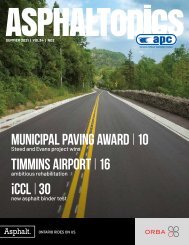ASPHALTopics | Fall 2020 | VOL 33 | NO 3
Create successful ePaper yourself
Turn your PDF publications into a flip-book with our unique Google optimized e-Paper software.
crack sealants are no longer effective<br />
and the owner does not have funding<br />
to perform conventional repairs and<br />
rehabilitation. These sections have<br />
been in place anywhere from a few<br />
months to more than three years in<br />
cities including the City of Hamilton,<br />
City of Cambridge, Niagara-on-the-<br />
Lake, and City of Brantford.<br />
The City of Cambridge has been using<br />
MACSEAL M.A.R.S. to preserve its<br />
pavement in addition to milling down<br />
damaged areas and refilling them with<br />
HMA. “Cambridge is looking for new<br />
methods and technologies to aid in<br />
pavement preservation,” Laros says.<br />
“We started to use polyolefin fibres in<br />
our asphalt when we are doing partial<br />
depth resurfacing to help prolong<br />
the life of the road surface. We apply<br />
another durable water proof coating<br />
‘Liquid Road’ to our chip seal roads<br />
to help lessen water penetration and<br />
prolong chip seal roads.”<br />
The brooms scrub the asphalt emulsion into cracks and gaps in the roadway,<br />
as well as providing a protective seal over the entire treated surface. A specially<br />
formulated emulsion is used to rejuvenate the existing asphalt cement, restoring<br />
some of its flexibility.<br />
FiberMat is a stress absorbing membrane interlayer (SAMI). It is not typically left<br />
exposed to traffic and is usually placed on an existing or milled surface before<br />
a standard overlay or cover aggregate application. FiberMat combats reflective<br />
cracking by laying down a layer of polymer-modified asphalt emulsion onto the<br />
roadway, followed by a layer of chopped fiberglass strands. Next, a second ››<br />
Norjohn Contracting offers several<br />
products to support pavement<br />
preservation including Ultra-Thin<br />
Bonded Wearing Course, Scrub Seal<br />
and FiberMat. Ultra-Thin Bonded<br />
Wearing Course is placed on asphalt<br />
surfaces using a specialized spray<br />
paver. The process begins with a<br />
heavy application of a polymer-modified<br />
asphalt emulsion onto the roadway,<br />
followed by the paving screed. A smooth<br />
drum roller helps seat the aggregate<br />
into the heavy bond coat to provide a<br />
smooth riding surface. The entire lift<br />
is approximately 15 mm thick and does<br />
not require compaction.<br />
According to the company, Ultra-<br />
Thin Bonded Wearing Course requires<br />
minimal preparation, seals the existing<br />
pavement, and restores ride and skid<br />
resistance. Once the materials have<br />
been placed, the road can be reopened<br />
to regular traffic within 15 minutes.<br />
Scrub Seal works much like applying<br />
a chip seal treatment to a roadway.<br />
The difference lies in the array of<br />
differently-angled broom heads<br />
dragged behind the application truck.<br />
FALL <strong>2020</strong> 29

















